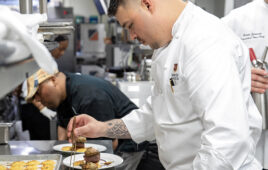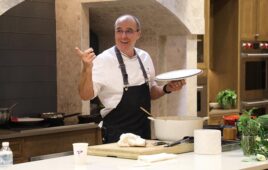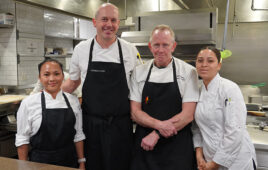
The Country Club of Virginia is one of the U.S.’s largest private clubs, with 7,400 members, 600 employees and an operating budget of more than $30 million. Keith Armstrong became CCV’s newest Executive Chef at the end of 2014.
Keith Armstrong has hit the ground running as the new Executive Chef at The Country Club of Virginia.
The Country Club of Virginia (CCV) was organized in 1908 and has grown to become one of the largest private country clubs in the country, with over 7,400 members, 600 employees and an operating budget of more than $30 million. As highlighted in C&RB’s February 2013 cover story (“Keeping Pace with Change at The Country Club of Virginia”), the influence of the club’s management mantra, “An evolution to excellence through continuous improvement,” can be seen in every part of this massive operation.
One of the newest members of CCV’s team is Executive Chef Keith Armstrong, who took the position at the end of 2014. As he describes in this interview, Chef Armstrong’s experiences in first presenting himself for the position, and then hitting the ground running from day one on the job, offer valuable career lessons for all club chefs. We thank Keith for taking time, while he was just settling in to his huge responsibilities managing all of CCV’s dining outlets, to share some of his initial thoughts on all that his new position will entail.
|
Current Position: Executive Chef, The Country Club of Virginia, Richmond, Va. (December 2014-Present) Previous Experience: Education: Associate Degree in Culinary Arts, The Art Institute of Atlanta, 1989 Awards and Affiliations: |
C&RB Chef, your interview process at CCV was something that you were really impressed by, and a main reason why you made a job change. Can you tell us a little about that experience?
Armstrong: The interview process started with a phone interview that was approximately two hours in length. I was then asked to return for an on-site interview that would require two full days to complete. I met with all of the food-and-beverage managers and had approximately a half-hour interview with each of them. I then spent about three hours interviewing with the General Manager [Phil Kiester], which was a great opportunity to see the club operations through his perspective.
I was then required to do the normal tasting format and send a menu with all of the ingredients that I would be utilizing. I used the multiple outlets of the club to assist me with my menu, by creating dishes similar to the style of each restaurant (see menu above). I was assisted with my prep by the executive sous chef, and we prepped 256 components within a four-hour period.
The format stated that each course should be presented within a 10-minute window. The meal was comprised of seven courses, with eight plates of each. I then finished up with an additional dinner meeting attended by the Director of Clubhouse Operations, the Human Resources Director, and the General Manager.
The interview process provided me with a great deal of insight on the club’s culture and its defining principles. The CCV management team followed the most complete and informative interview process that I have ever been a part of during my career, and the culinary team did a fabulous job hosting me in the kitchen; they were extremely professional and accommodating.
C&RB: Then on your second day on the job, you executed the annual Holiday Dinner for CCV’s Board members. What did you do to seize this opportunity and make an instant impact?
Armstrong: This was a wonderful opportunity for me to provide the membership with some insight on the things to come at The Country Club of Virginia. It was also a great opportunity to prep with the team and begin to start understanding the facility layout. The culinary team and I spent two full days preparing this meal for our Board of Directors’ annual Christmas dinner (to view the menu, see the online version of this article at clubandresortbusiness.com).
C&RB: You came from a busy club in Connecticut [Greenwich Country Club] with multiple restaurant outlets similar to CCV, but now your F&B volume has doubled. How are you transitioning, and how will you adjust where you focus your energies?
Armstrong: I came from an environment that required a great deal of hands-on work, and that was nice. But sometimes you need a core of managers, as you can’t be in three restaurants at one time.
At The Country Club of Virginia, I have an executive sous chef as well as an outlet chef and sous chef in each restaurant. This gives you the ability to run a complete program where delegation is the key to our success.
The focus of our program is about building true culinary discipline through training and education. This will help grow the program through staff development, and provide longevity to our food quality and skill set. I preach to the team to not get stuck in the rut of just coming to work—let’s work on achieving every day. I have encouraged every staff member to believe in hard work and set their sights on the next step of the culinary ladder.
C&RB: What is the biggest difference between cooking in New England and cooking in the South?
Armstrong: The one major difference is the style of food. I am also still working on sourcing products, but the availability of specialty items is not as accessible in a quick timeframe.
Members are extremely knowledgeable about food in the areas where they reside. They are aware of what local restaurants are offering on menus. A chef needs to represent different styles of food, so diversity is imperative in our food program, in order to stay relevant with culinary trends.
C&RB: In situations like yours, what should incoming chefs put at the top of their list of priorities before designing new menus and plates?
Armstrong: I believe you must find whatever it takes to motivate your team and get them engaged in the program improvements. I think a new chef needs to be open and listen to the team that has been in the operation for a longer period than he or she has. I have already learned a tremendous amount from my managers, outlet chefs and the line staff.
The foundation of core culinary principles is the key to building and improving a culinary program. It must first start with getting the operation and the team organized, and that will provide dividends on both efficiency and quality.
When the team begins to see their work environment improve, it creates purpose and motivation. I believe that letting every team member know that they are valuable to the club’s success goes a long way. You see it, you own it, you solve it—and you do it.
C&RB: One of the most underrated morale-boosting tools in clubs is staff meals. What did you implement in this area at CCV after arriving?
Armstrong: We provide meals for staff, both lunch and dinner, seven days a week. We designed a new menu that gives our team multiple options for lunch and dinner, and now strive to present the staff meals in a manner that is aesthetically pleasing. This is also one of the best tools to get team members to see that there is a shift to improve.







